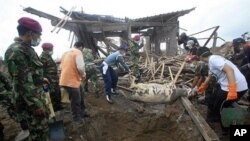Fifty Asian and Pacific countries have agreed to make risk reduction part of their climate change policies.
The rising death toll from a tsunami and a volcano in Indonesia this week underscored the effort to reduce disaster casualties and damage.
Disaster management officials from 50 Asia-Pacific countries attended the three-day Asian Ministerial Conference on Disaster Risk Reduction.
Officials say while less than 40 percent of the world's disasters occur in Asia, more than 90 percent of victims are found in this heavily populated region.
One focus of the meeting was the need to adapt to a warming climate, which can cause disasters such as floods and droughts.
Ministers at the conference adopted a five-year plan for managing climate risks through technology use, such as establishing information-sharing systems.
Margareta Wahlstrom is the special representative of the United Nations Secretary-General for Disaster Risk Reduction. She says this is the first time governments, at the regional level, have integrated climate change risk management into their overall disaster risk reduction programs.
"This is not a task that is too difficult. It is achievable because we see that countries are making progress," Wahlstrom said. "Countries are taking from their own investments, even if they aren't very rich, and they're making investments in prevention and risk reduction into the development budgets."
As the ministers began meeting in South Korea on Monday, a massive earthquake shook islands off western Sumatra. That triggered a tsunami, which left hundreds dead. A volcano about 1,300 kilometers to the east, in central Java, erupted the next day, causing additional deaths.
The region is also grappling with the effects of recent tropical cyclones, which did heavy damage in the Philippines, China and Burma. And in Thailand and Indonesia, governments are trying to help victims of unusually heavy rainy season floods.











